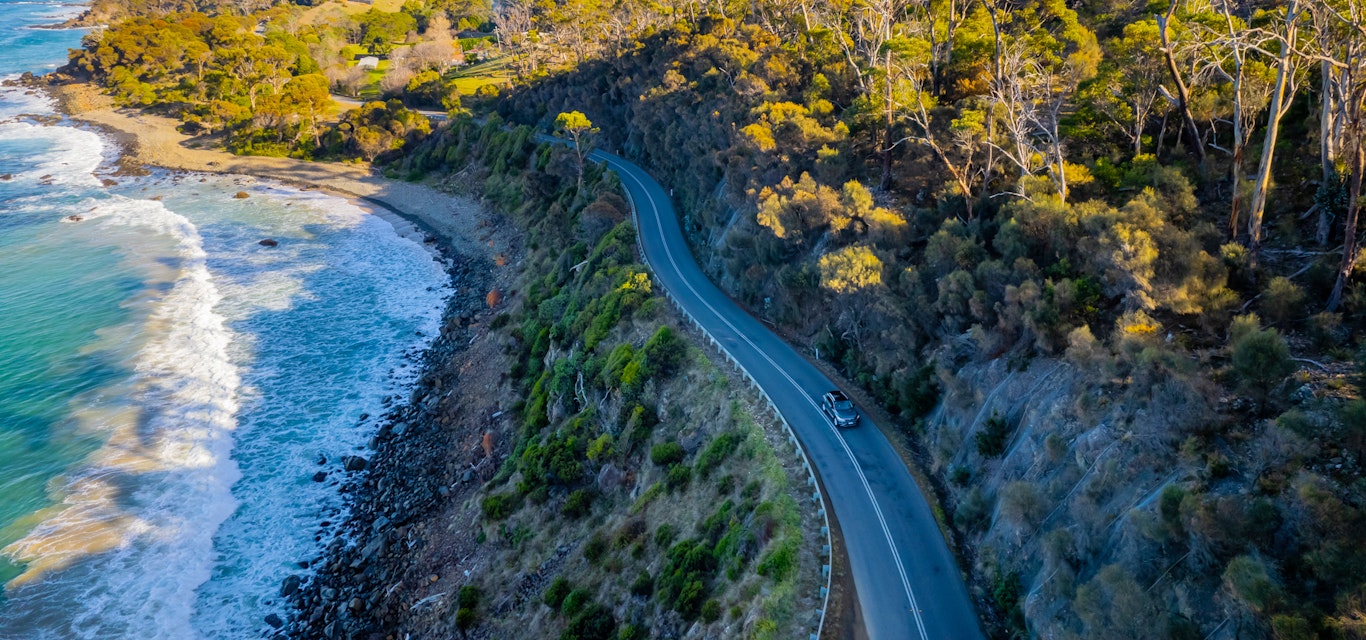Road test: Volkswagen T-Roc Style
We put the Volkswagen T-Roc Style through its paces on the Great Eastern Drive from Orford to Freycinet National Park.
Picture an SUV and it’s often about space and school drop-offs – something exploratory in appearance but urban in its manner. But sitting inside a Volkswagen T-Roc Style as I drive along Tasmania’s East Coast, it’s difficult to remember that this is an SUV.
Inside, the T-Roc feels much like the interior of my partner’s VW Golf, only sitting higher on the road. It’s a Golf on platform shoes.
As morning sun pours down in its customary East-Coast fashion, I’m on my way to Freycinet National Park on the Great Eastern Drive, Tasmania’s contender to be Australia’s true great ocean road. From the south, its starting line is the Prosser River in Orford and there’s a sense of coastal greatness even as I exit town along Raspins Beach, with Maria Island rising tall out of the sea, its peaks underscored by the clearings of Darlington.
What I like immediately about the compact T-Roc is its unobtrusive nature, with little road noise and minimal dings and bings as I drive – none of that overbearing, chatty-car annoyance every time it thinks you’ve gone off-script – leaving me with my thoughts and this beautiful coast. This understated quality extends throughout the vehicle. VW’s best-selling model, the T-Roc brings all the comfort you expect of the German manufacturer, but it’s not about bells and whistles. There’s no seat heating and no electronic seat adjustment, and there’s nostalgic enjoyment in finding old-fashioned volume and tuning dials set within the eight-inch touch-screen media system. It’s a vehicle that brings back simple without sacrificing anything in comfort.
Past Triabunna, the coast briefly turns into an ellipsis of lagoons, with black swans cruising among the reeds. The slopes and fields around the lagoons are still green and quenched from the winter rains, and the first coffee of the day – from Gray Cafe, the roadside coffee stop in a shed – comes in readiness for the drive’s wildest and most spectacular stretch.
As the road climbs through Rocky Hills, the T-Roc glides through the bends, the steering light, the vehicle responsive as the road wriggles past beaches and rocky coves. The T-Roc has only a 1.4-litre engine, but it’s turbocharged and still delivers plenty of kick (albeit not as much as the top-of-the-tree T-Roc R-Line), with smooth suspension that takes all the rocky out of Rocky Hills.
This is a stretch of coastline where the Great Eastern Drive is unquestionably great, swooping down off the hills to Kelvedon Beach and the loneliest and most picturesque boat shed in the state. I park the car and wander out onto the beach, scanning the flat bay for whales, which are often seen in Great Oyster Bay as they make their springtime migration towards Antarctic waters. This day, the sea is empty but the sky is full, with a wedge-tailed eagle circling gracefully overhead. Across the bay, the peaks of Freycinet and Schouten Island seem to grow out of the sea, with smaller islands running off the southern tip of Schouten like stepping stones into the Tasman Sea.
There are glimpses of the Great Eastern Drive’s wilder past in the likes of Spiky Bridge, its quill-like parapets recalling a time when the road was nothing more than a convict-built coach road. Possibly built to stop livestock climbing over the edge of the bridge, or perhaps just as a folly, the spiny bridge half resembles the mani walls you find along Himalayan trekking trails.
The road’s more civilised present is encapsulated in the presence of a host of fine eating options and a clutch of wineries around Cranbrook. High among the possibilities is the chance to indulge in oysters plucked fresh from the racks at Freycinet Marine Farm, just outside of Coles Bay, and Melshell Oyster Shack.
It’s to the latter that I’m soon detouring, turning off the highway and skirting the edge of Nine Mile Beach past holiday homes with names like Bonnie Dune and The Get Away. The road ends in sand, Melshell’s quirky, retro caravan parked beside a low line of dunes on the bank of the Swan River estuary. From Melshell’s dune-top tables, I look out over the racks, where cormorants stand airing their wings in the middle of the river. Behind me, Freycinet Peninsula’s Hazards mountains are little more than 10km away as the cormorant flies, and yet my drive to reach them is little more than half done.
I return to the highway and turn north again, burrowing between vineyards and groves of walnut trees. As the drive climbs through Cherry Tree Hill, there’s another chance to enjoy the T-Roc’s unfailing grip on the road, until soon I’m looking out again onto the Hazards from the slopes above Devil’s Corner.
Even as recently as the 1980s, the side road to Coles Bay and Freycinet was so notorious that cars sported bumper stickers declaring “I survived the Coles Bay Road”, but the drive today is seamless as the road skims the shores of Moulting Lagoon’s precious wetlands.
Soon, the bare granite slopes of the Hazards rise like the ultimate road barrier, and it is indeed here that roads end and walking tracks begin into the national park. Everything about this drive to Freycinet has felt clean, from the muted road noise inside the T-Roc, to its crisp, uncluttered instrument display, to this national park at the journey’s end. The road – and my road trip – finish at the Wineglass Bay car park, with walking options aplenty. Wineglass Bay? Mt Amos? Hazards Beach? I can’t lose.
The specs
Pricing: from $42,990
Body style: SUV
Seating: 5 seats
Fuel Consumption: 6.3L/100km
Engine type: 4-cylinder 1.4L turbo petrol
Transmission: 8-speed automatic
Drive type: front wheel drive
Max power: 110kW
Max torque: 250Nm
0-100km/h: 8.7 seconds
Safety: not yet rated by ANCAP
